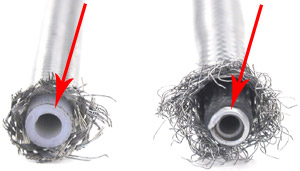 |
Another common
problem with some after market stainless steel braided cables is
their overall length shrink factor. As the cable is pulled, linear
pressure is placed on the nylon tubing inner liner (see picture
at the far left) of these cables. This causes the cable to physically
become shorter in length as the apply pressure is increased. The
factory throttle, detent and TV cables all use a steel lining (see
the picture on the right) which maintains its length under stress
and resists becoming shorter when pressure is applied!
The plastic tubing shrink problem gets progressively worse as the
engine compartment warms up since the plastic tubing is a thermoplastic
that becomes softer as it gets hotter! As this occurs, the actual
cable pull distance becomes less and less. A throttle cable with
this problem will stop reaching its full W.O.T. position; this results
in loss of high rpm power. Our personal experience with customer's
cars, that enter our shop which, have this style throttle cable system,
over 60% of them will not cause the carburetors linkage to reach
wide open when the engine is at operating temperature! The
owners are stunned to say the least! This condition can be easily
checked. Once the engine compartment is up to normal operating temperature,
shut the engine off and immediately have a friend press the accelerator
pedal to the floor, while you try to rotate the carburetor's linkage
further, if you can, you have the problem!
Lack of power if the throttle fails to reach its full wide open
position is not a serious problem, disappointing maybe, but will not
cause damage to anything. The effect this condition has on a Th-700R4
or Th-2004R is an entirely different situation and can have very
serious consequences. If the throttle linkage doesn't reach
its full wide open throttle position, the communications to the
transmission via the TV cable can't possibly perform its function
correctly!
The critical function of the TV cable system is to boost the operating
pressures as the throttle is applied. Increased boost pressures
are necessary to offset increased torque output from the vehicles
engine as the throttle is applied. A cable that changes length cannot
maintain its proper pull function. If engine torque production becomes
greater than the transmission hydraulic clamping pressures, clutches
and bands will slip, which can shorten the transmissions life dramatically,
especially in overdrive (fourth gear). This problem can dramatically
affect the shift characteristics of the transmission. Precise consistent
management of this critical system is absolutely necessary for correct
transmission operation and longevity. We prevent this problem by
using a steel lined cable instead of the nylon tubing as a conduit.
|

